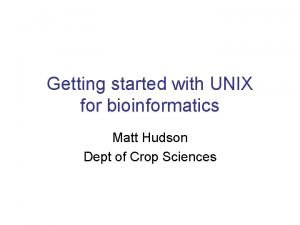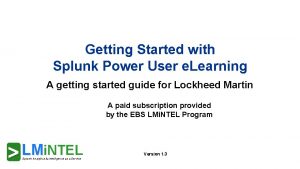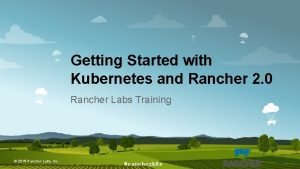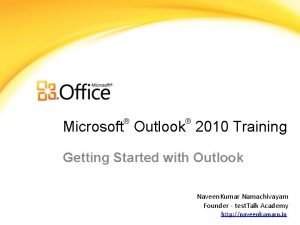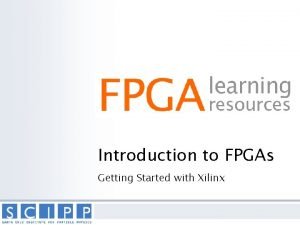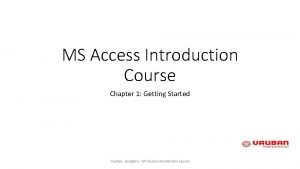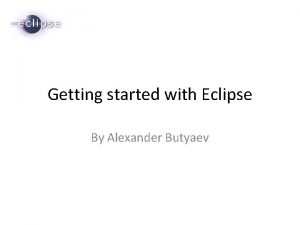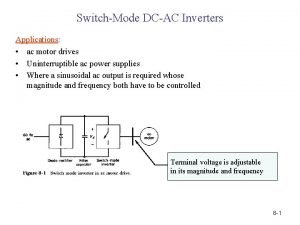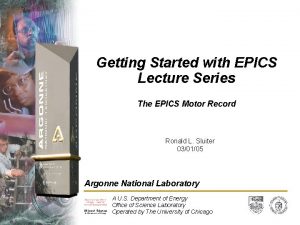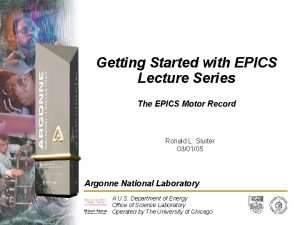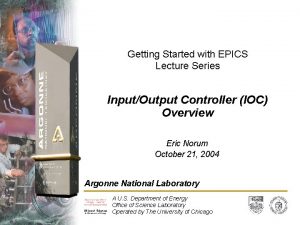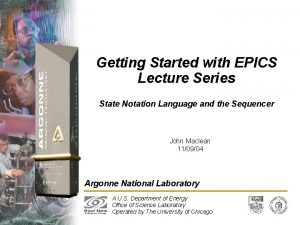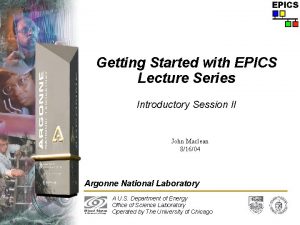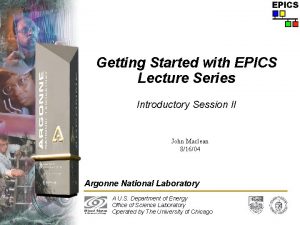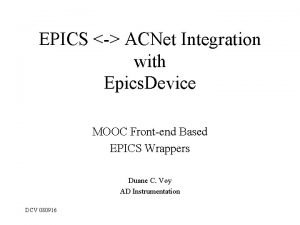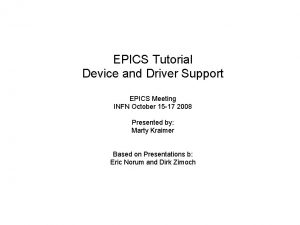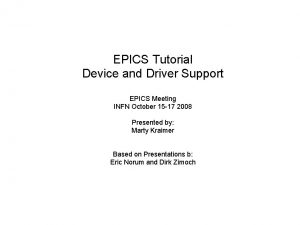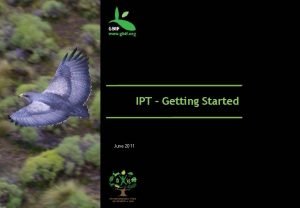Getting Started with EPICS Lecture Series Writing Device



























- Slides: 27

Getting Started with EPICS Lecture Series Writing Device Support Eric Norum November 16, 2004 Argonne National Laboratory Office of Science U. S. Department of Energy A U. S. Department of Energy Office of Science Laboratory Operated by The University of Chicago

Writing Device Support – Scope • • • An overview of the concepts associated with writing EPICS Device Support routines. Examples show the “stone knives and bearskins” approach. The ASYN package provides a framework which makes writing device support much easier. - The concepts presented here still apply. Pioneering Science and Technology Office of Science U. S. Department of Energy

Writing Device Support – Outline • • What is ‘Device Support’? The. dbd file entry The driver DSET Device addresses Support routines Using interrupts Asynchronous input/output Callbacks Pioneering Science and Technology Office of Science U. S. Department of Energy

What is ‘Device Support’? • • Interface between record and hardware A set of routines for record support to call - The record type determines the required set of routines - These routines have full read/write access to any record field Determines synchronous/asynchronous nature of record Performs record I/O - Provides interrupt handling mechanism Pioneering Science and Technology Office of Science U. S. Department of Energy

Why use device support? • • • Could instead make a different record type for each hardware interface, with fields to allow full control over the provided facilities. A separate device support level provides several advantages: - Users need not learn a new record type for each type of device - Increases modularity - I/O hardware changes are less disruptive - Device support is simpler than record support - Hardware interface code is isolated from record API Custom records are available if really needed. - By which I mean “really, really needed!” - Existing record types are sufficient for most applications. Pioneering Science and Technology Office of Science U. S. Department of Energy

How does a record find its device support? ��� Through. dbd ‘device’ statements: Pioneering Science and Technology Office of Science U. S. Department of Energy

The. dbd file entry • • • The IOC discovers device support from entries in. dbd files device(rec. Type, addr. Type, dset. Name, ”dtype. Name”) addr. Type is one of AB_IO BITBUS_IO CAMAC_IO GPIB_IO INST_IO RF_IO VME_IO VXI_IO dset. Name is the name of the C Device Support Entry Table (DSET) • By convention name indicates record and hardware type: device(ai, GPIB_IO, dev. Aidg 535, "dg 535") device(bi, VME_IO, dev. Bi. Xy 240, "XYCOM-240") Pioneering Science and Technology Office of Science U. S. Department of Energy

The DSET • • A C structure containing pointers to functions Content dependent upon record type Each device support layer defines a DSET with pointers to its own functions A DSET structure declaration looks like: struct dset { long number; long (*report)(int level); long (*initialize)(int pass); long (*init. Record)(struct … *precord); long (*get. Io. Int. Info)(…); … read/write and other routines as required }; number specifies number of pointers (often 5 or 6) A NULL is given when an optional routine is not implemented DSET structures and functions are usually declared static Pioneering Science and Technology Office of Science U. S. Department of Energy

The DSET – initialize long initialize(int pass); • Initializes the device support layer • Optional routine, not always needed • Used for one-time startup operations: - Start background tasks - Create shared tables • Called twice by ioc. Init() - pass=0 – Before any record initialization - Doesn’t usually access hardware since device address information is not yet known - pass=1 – After all record initialization - Can be used as a final startup step. All device address information is now known Pioneering Science and Technology Office of Science U. S. Department of Energy

The DSET – init. Record long init. Record(struct … *precord); • Called by ioc. Init() once for each record with matching DTYP • Optional routine, but usually supplied • Routines often - Validate the INP or OUTP field - Verify that addressed hardware is present - Allocate device-specific storage for the record - Each record contains a void *dpvt pointer for this purpose - Program device registers - Set record-specific fields needed for conversion to/from engineering units Pioneering Science and Technology Office of Science U. S. Department of Energy

The DSET – init. Record – Device Addresses • Device support. dbd entry was device(rec. Type, addr. Type, dset, "name") • addr. Type specifies the type to use for the address link, e. g. device(bo, VME_IO, dev. Bo. Xy 240, "Xycom XY 240") sets pbo->out: - pbo->out. type = VME_IO - Device support uses • pbo->out. value. vmeio which is a struct vmeio { short card; short signal; char *parm; }; IOC Application Developer’s Guide describes all types Pioneering Science and Technology Office of Science U. S. Department of Energy

The DSET – report long report(int level); • Called by dbior shell command • Prints information about current state, hardware status, I/O statistics, etc. • Amount of output is controlled by the level argument - level=0 – list hardware connected, one device per line - level>0 – provide different type or more detailed information Pioneering Science and Technology Office of Science U. S. Department of Energy

The DSET – read/write long read(struct … *precord); long write(struct … *precord); • Called when record is processed • Perform (or initiate) the I/O operation: - Synchronous input - Copy value from hardware into precord->rval - Return 0 (to indicate success) - Synchronous output - Copy value from precord->rval to hardware - Return 0 (to indicate success) Pioneering Science and Technology Office of Science U. S. Department of Energy

A simple example (vx. Works or RTEMS) #include <rec. Gbl. h> #include <dev. Sup. h> #include <dev. Lib. h> #include <bi. Record. h> #include <epics. Export. h> static long init. Record(struct bi. Record *prec){ char *pbyte, dummy; if ((prec->inp. type != VME_IO) || (prec->inp. value. vmeio. signal < 0) || (prec->inp. value. vmeio. signal > 7)) { rec. Gbl. Record. Error(S_dev_bad. Inp. Type, (void *)prec, "dev. Bi. First: Bad INP"); return -1; } if (dev. Register. Address("dev. Bi. First", at. VMEA 16, prec->inp. value. vmeio. card, 0 x 1, &pbyte) != 0) { rec. Gbl. Record. Error(S_dev_bad. Card, (void *)prec, "dev. Bi. First: Bad VME address"); return -1; } if (dev. Read. Probe(1, pbyte, &dummy) < 0) { rec. Gbl. Record. Error(S_dev_bad. Card, (void *)prec, "dev. Bi. First: Nothing there!"); return -1; } prec->dpvt = pbyte; prec->mask = 1 << prec->inp. value. vmeio. signal; return 0; } Pioneering Science and Technology Office of Science U. S. Department of Energy

A simple example (vx. Works or RTEMS) static long read(struct bi. Record *prec) { volatile char *pbyte = (volatile char *)prec->dpvt; prec->rval = *pbyte; return 0; } static struct { long number; long (*report)(int); long (*initialize)(int); long (*init. Record)(struct bi. Record *); long (*get. Io. Int. Info)(); long (*read)(struct bi. Record *); } dev. Bi. First = { 5, NULL, init. Record, NULL, read }; epics. Export. Address(dset, dev. Bi. First); Pioneering Science and Technology Office of Science U. S. Department of Energy

A simple example – device support. dbd file The. dbd file for the device support routines shown on the preceding pages might be device(bi, VME_IO, dev. Bi. First, “simple. Input”) Pioneering Science and Technology Office of Science U. S. Department of Energy

A simple example – application. db file An application. db file using the device support routines shown on the preceding pages might contain record(bi, "$(P): status. Bit") { field(DESC, "Simple example binary input") field(DTYP, "simple. Input") field(INP, "#C$(C) S$(S)") } Pioneering Science and Technology Office of Science U. S. Department of Energy

A simple example – application startup script An application startup script (st. cmd) using the device support routines shown on the preceding pages might contain db. Load. Records("db/example. db", "P=test, C=0 x 1 E 0, S=0") which would expand the. db file into record(bi, "test: status. Bit") { field(DESC, "Simple example binary input") field(DTYP, "simple. Input") field(INP, "#C 0 x 1 E 0 S 0") } Pioneering Science and Technology Office of Science U. S. Department of Energy

Useful facilities • • • ANSI C routines (EPICS headers fill in vendor holes) - epics. Stdio. h – printf, sscanf, epics. Snprintf - epics. String. h – strcpy, memcpy, epics. Str. Dup - epics. Stdlib. h – getenv, abs, epics. Scan. Double OS-independent hardware access (dev. Lib. h) - Bus address Local address conversion - Interrupt control - Bus probing EPICS routines - epics. Event. h – process synchronization semaphore - epics. Mutex. h – mutual-exclusion semaphore - epics. Thread. h – multithreading support - rec. Gbl. h – record error and alarm reporting Pioneering Science and Technology Office of Science U. S. Department of Energy

Device interrupts • • • vx. Works/RTEMS interrupt handlers can be written in C VME interrupts have two parameters - Interrupt level (1 -7, but don’t use level 7) – often set with onboard jumpers or DIP switches - Interrupt vector (0 -255, <64 reserved on MC 680 x 0) – often set by writing to an on-board register OS initialization takes two calls 1. Connect interrupt handler to vector dev. Connect. Interrupt. VME(unsigned vector. Number, void (*p. Function)(void *), void *parameter); 2. Enable interrupt from VME to CPU dev. Enable. Interrupt. Level. VME (unsigned level); Pioneering Science and Technology Office of Science U. S. Department of Energy

I/O interrupt record processing • • • Record is processed when hardware interrupt occurs Granularity depends on device support and hardware - Interrupt per-channel vs. interrupt per-card #include <db. Scan. h> to get additional declarations Call scan. Io. Init once for each interrupt source to initialize a local value: scan. Io. Init(&ioscanpvt); DSET must provide a get. Io. Int. Info routine to specify the interrupt source associated with a record – a single interrupt source can be associated with more than one record Interrupt handler calls scan. Io. Request with the ‘ioscanpvt’ value for that source – this is one of the very few routines which may be called from an interrupt handler Pioneering Science and Technology Office of Science U. S. Department of Energy

The DSET – get. Io. Int. Info long get. Io. Int. Info(int cmd, struct … *precord, IOSCANPVT *ppvt); • Set *ppvt to the value of the IOSCANPVT variable for the interrupt source to be associated with this record • Must have already called scan. Io. Init to initialize the IOSCANPVT variable • Return 0 to indicate success or non-zero to indicate failure – in which case the record SCAN field will be set to Passive • Routine is called with - (cmd=0) when record is set to SCAN=I/O Intr - (cmd=1) when record SCAN field is set to any other value Pioneering Science and Technology Office of Science U. S. Department of Energy

The DSET – special. Linconv long special. Linconv(struct … *precord, int after); • Analog input (ai) and output (ao) record DSETs include this sixth routine • Called just before (after=0) and just after (after=1) the value of the LINR, EGUL or EGUF fields changes • “Before” usually does nothing • “After” recalculates ESLO from EGUL/EGUF and the hardware range • If record LINR field is Linear ai record processing will compute val as val = ((rval + roff) * aslo + aoff) * eslo + eoff Ao record processing is similar, but in reverse Pioneering Science and Technology Office of Science U. S. Department of Energy

Asynchronous I/O • • • Device support must not wait for slow I/O Hardware read/write operations which take “a long time” to complete must use asynchronous record processing - TI/O 100 s – definitely “a long time” - TI/O 10 s – definitely “not a long time” - 10 s < TI/O < 100 s – ? ? ? If device does not provide a completion interrupt a “worker” thread can be created to perform the I/O - this technique is used for Ethernet-attached devices Pioneering Science and Technology Office of Science U. S. Department of Energy

Asynchronous I/O – read/write operation • • • Check value of precord->pact and if zero: - Set precord->pact to 1 - Start the I/O operation - write hardware or send message to worker thread - Return 0 When operation completes run the following code from a thread (i. e. NOT from an interrupt handler) struct rset *prset = (struct rset *)precord->rset; db. Scan. Lock(precord); (*prset->process)(precord); db. Scan. Unlock(precord); The record’s process routine will call the device support read/write routine – with precord->pact=1 - Complete the I/O, set rval, etc. Pioneering Science and Technology Office of Science U. S. Department of Energy

Asynchronous I/O – callbacks • • • An interrupt handler must not call a record’s process routine directly Use the callback system (callback. h) to do this Declare a callback variable CALLBACK my. Callback; Issue the following from the interrupt handler callback. Request. Process. Callback(&my. Call. Back, priority. Low, precord); This queues a request to a callback handler thread which will perform the lock/process/unlock operations shown on the previous page There are three callback handler threads - With priorities Low, Medium and High Pioneering Science and Technology Office of Science U. S. Department of Energy

Asynchronous I/O – ASYN • • • This should be your first consideration for new device support It provides a powerful, flexible framework for writing device support for - Message-based asynchronous devices - Register-based synchronous devices Will be completely described in a subsequent lecture Pioneering Science and Technology Office of Science U. S. Department of Energy
 The secret of getting ahead is getting started
The secret of getting ahead is getting started Getting started with vivado
Getting started with vivado Getting started with unix
Getting started with unix Education.splunk.com
Education.splunk.com Rancher slack
Rancher slack Getting started with excel
Getting started with excel Getting started with microsoft outlook learning
Getting started with microsoft outlook learning Getting started with xilinx fpga
Getting started with xilinx fpga Lua getting started
Lua getting started Unit 1 hobbies
Unit 1 hobbies Unit 1 local environment
Unit 1 local environment Unit 1 getting started
Unit 1 getting started Linkedin getting started
Linkedin getting started Getting started with vivado
Getting started with vivado Dr jeffrey roach
Dr jeffrey roach Getting started with ft8
Getting started with ft8 English 9 unit 3
English 9 unit 3 Unit 1 getting started
Unit 1 getting started Poll everywhere register
Poll everywhere register Android development getting started
Android development getting started Tipos de habilidades del pensamiento
Tipos de habilidades del pensamiento Getting started with eclipse
Getting started with eclipse Hakan kutucu
Hakan kutucu Ram input or output device
Ram input or output device 01:640:244 lecture notes - lecture 15: plat, idah, farad
01:640:244 lecture notes - lecture 15: plat, idah, farad Paola stipo
Paola stipo Geology lecture series
Geology lecture series Dcac lecture series
Dcac lecture series


